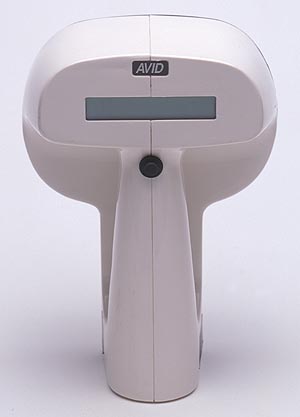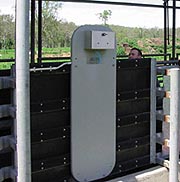|
Who
gets tagged?
From the earliest city states to today, the people in
power have always wanted to be able to identify other
people and animals and keep track of them.
Perhaps
the most obvious way of doing this is to tag them. You
attach something to them or mark them in some way so
that you can always find out who they are even if they
can't tell you or don't want to tell you.
Another
way is to record something unique about them (like their
fingerprint) that you can use to identify them. This
is called biometrics. A similar way is to record
their DNA so you can do a genetic test to find out their
identity.
Tagging
animals
Ever since people started keeping animals for food instead
of just hunting them, they have needed to be able to
keep track of the animals they own.
Keeping
livestock animals is part of a system of food production.
A system as important as that needs an information system
to control it, even if that information system is very
simple.
The
easiest way to keep track of livestock has always been
to mark the animal in some way.
Activity
Identify the participants, data or information and information
technology for a veterinary surgery's database for the
tagging of one type of animal.
Attaching
a tag
One way of tagging an animal is to put an actual tag
on it. Often people attach a marker to its ear. For
hundreds of years people in Europe and Africa have tagged
cows, sheep and goats by attaching a marker to the animal's
ear.
The
problems with these tags are:
- they
can fall off
- they
can be pulled out if the animal rubs against a tree
- someone
can take the tag out and replace it with their own
tag.
Altering
appearances
One way around this problem has been to change something
about the way the animal looks. For example clipping
a piece of an animal's ear or another part of their
body.
The
most common way of changing the animal is to brand it
by burning an identification mark into the animal's
hide.
In
more recent times people have wanted to identify and
keep track of animals like pets, endangered species
in the wild, and animals in zoos. In situations like
these cutting or burning the animal's skin is not appropriate.
Electronic
tagging
New technology allows animals to be tagged electronically.
The technology used by the United States to tag Haitian
and Cuban refugees in 1994 was originally designed for
tagging pets.
Instead
of attaching a plastic tag to an animal's ear, or branding
it, a microchip can be put under the animal's skin.
The microchip has a unique number that can be read by
a scanner. You hold the scanner near the part of the
animal that has the chip, and it tells you the number.
That way you can identify exactly which animal it is.
The
system was implemented to ensure that lost pets were
returned to their owners. Your dog or cat or pet lizard
may have a chip under its skin. The number is recorded
in a central database. Anyone who finds a pet animal
can take it to a vet or the RSPCA, and they can scan
for the number and find out whose pet it is.

An
AVID remote frequency identification (RF/ID) chip.
Each one has its own unique ID number. Powerhouse
Museum collection. |

This
fat syringe is used to put the chip under an animal's
skin. It doesn't hurt though.
Powerhouse Museum collection. |
|

An
AVID chip reader. It gives a readout of the ID
number and can be plugged directly into a computer.
Powerhouse
Museum collection.
|
Activity
Identify the issues raised so far on tagging.
AVID
technology is used to tag pets.
Tagging
pets with microchips is now so common that the NSW Government
has introduced regulations about how animals can be
tagged.
Tagging
other animals
Once the technology had been developed to tag pets
with microchips, people started using it to tag
other kinds of animals. Now it is used to tag animals
in all kinds of different situations, from laboratory
rats to cattle. |

The
RFID device on the ear of a cow. Courtesy:
Global Supermarket magazine. |
|
The National Livestock Identification System (NLIS)
has been developed by Meat and Livestock Australia (MLA)
in collaboration with SAFEMEAT, a government and industry
initiative with the assistance of the Australian cattle
producers and processors. The system uses radio frequency
identification (RFID) devices that are placed in the
ear of the cattle or in the rumen of the animal with
a bolus.

Reading
the RFID device using a hand-held reader. Courtesy:
Global Supermarket magazine. |

RFID
reader mounted on the cattle race. Courtesy: Global
Supermarket magazine. |

RFID
reader mounted on the cattle race. Courtesy: Global
Supermarket magazine. |
Tagging
is not the only way people use to identify and keep
track of animals. Sometimes things about an animal's
body can be recorded a bit like the way people can be
fingerprinted. Click
here to find out about animal biometrics.
Tagging
people
In 1994 the United States used microchips to tag refugees.
This was done to help process their applications for
asylum in the USA.
But
this is not the only reason why people have been tagged
in the past. Over the centuries, people have tried to
control other people, and they've always found a way
to do it by tagging them.
Slavery
has existed for thousands of years. Perhaps the best
known example today is the kidnapping of people from
Africa to be used as slaves. It became common to brand
the slaves by burning
a design onto their skin with hot metal.
Another
example of the tagging of people was the tattooing of
ID numbers onto the arms of concentration camp prisoners
by the Nazis during World War II.
These
tags become symbols of ownership and domination.
Other
numbers
In our modern society there are many reasons for implementing
information systems. All sorts of organisations use
information systems to identify and keep track of their
own staff or people they deal with outside the organisation.
This includes:
- people
with bank accounts have account numbers
- employees
have employee numbers
- staff
with security clearance have pin numbers
- drivers
have drivers licence numbers
- everyone
who works in Australia has a tax file number
- children
have school ID numbers.
New
information technology
New information technology gives us many ways to provide
people with identification:
- photo
ID cards
- smart
cards
- bar
codes
- biometrics,
such as finger scanning or voice recognition
- implanted
microchips
- global
positioning transmitters.
Student
ID cards
In some schools in America student ID cards have a bar
code. In the USA everyone has a Social Security Number,
even if they don't get government benefits. It operates
as a national ID number for all citizens. Some schools
have ID cards with a bar code recording the student's
Social Security Number.
There
have been objections to this, students have won battles
to have the barcodes
removed.
In
America there has been talk of using pin numbers, electronic
fingerprint scans, or even voice recognition, to allow
kids to buy on their account at the school canteen.
In some United States schools access to the actual school
site is only permitted with an appropriate pin number
of some other identification.
Bar
coded data is used in the school's library system for
borrowing books in many Australian schools.
Activity
Make an appointment with your school or local librarian
to discuss the use of bar coding.
Implanting
microchips
Some people complain that if this is taken to its logical
conclusion, kids could end up implanted with a microchip,
like the ones some people put in their pets. The kids
could be scanned as they come and go from school, to
keep track of who's in the building. See one vision
of this possible
future.
This
technology is being developed as a counter measure for
people who are likely kidnap targets. The microchip
is hidden inside the person's body. Maybe even they
don't know where in their body it is. Their location
can always be tracked by satellite. The chip gets its
power from energy generated by the person's own body.
If they die, the chip will stop transmitting. The searchers
will know the person is dead, even if they haven't found
them yet.
This
would be great for preventing kidnapping, however it
may be used for other purposes.
African
slaves
For hundreds of years European empires took men, women
and children from Africa to be slaves. Most of the slaves
spent the rest of their lives doing all the hard work
in European colonies in North and South America and
the Caribbean.
Sometimes
Europeans got the slaves by kidnapping them from their
villages. Most of the time they just bought them at
slave markets from African or Arab slave traders.
The
owners of slaves sought ways to protect their property.
In 1440 the Portuguese started branding slaves by burning
a mark on their skin to show who they belonged to.
After
that, other Europeans like the Spanish, French, English
and Dutch started branding their slaves. That became
the normal way slave owners controlled information about
their African slaves. Some even branded their slaves
with a cross once they had baptised them as Christians.
Some
of the refugees who were tagged at the Guantanamo Bay
Naval Base in 1994 would have been descendants of Africans
who were branded and taken to Haiti and Cuba as slaves.
The
branding of slaves was a way of integrating them into
an information system, but it was quite a primitive
information system. The brand just showed who they belonged
to, not their individual identity in that system.
Click
here to read more about the branding of African
slaves.
Nazis
In World War II Germany conquered many nearby countries.
At its peak, the Nazis controlled most of Europe. This
gave them absolute power over the lives of many millions
of people. Their plans included a scheme to get rid
of groups they thought were racially inferior to them.
It
is worth noting that the Germans took advantage of census
data to identify people who were from a Jewish or gypsy
background. This abuse of confidential data is why many
people raise concerns about the collection and storage
of personal information.
The
Nazis also saw people they conquered as an economic
resource or free labour. Some people, like Poles and
Russians, were to be slave races, who would live only
so they could work for the German economy.
The
Nazis wanted to treat their slave labour like a resource
and not like people, so they didn't use their names
to identify them. Instead they gave them ID numbers
which were tattooed onto their arm.
Everything
that made them look like individual people was taken
away and replaced with a visible number. This symbolically
turned them from people into material.
|